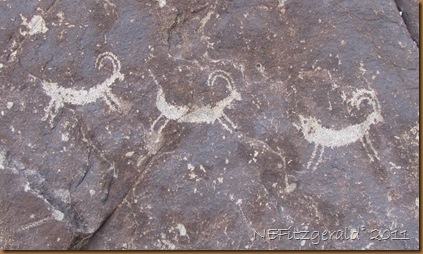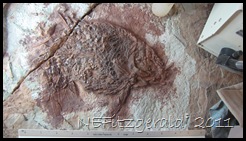Since returning two weeks ago from my four-day hiking extravaganza in southern Nevada and northwest Arizona, I have been doing a lot of thinking about mining and its long history in that part of the country. In Arizona, in particular, there have been a lot of copper minerals mined over at least the past century or more. Copper (chemical symbol Cu) is also mined in Utah in such places as the Bingham Mine up near Salt Lake City and smaller operations in the southern part of the state. Copper is actually mined in many places all over the country and the world, Chile in particular.
 |
| Native copper – scale in cm |
With that in mind, I began leafing through my digital folders in search of a presentation I gave several years ago in one of my geology classes. I had wondered why copper shows up where it does. I had wondered how copper gets to where it gets. I had found that copper could mineralize in rocks in certain areas of what is called skarn. I pondered the following:What the heck is skarn?What does quartz monzonite (a type of igneous intrusion related to granite that is present in my southern Utah study area) have to do with the skarn?How are skarns related to copper mineralization anyway?How do sulfides form? How do we get copper from them?What are the relationships between copper and many other magnificent minerals such as magnetite, chalcopyrite, cuprite, and chrysocolla? This pondering ultimately turned out to be yet another chapter in my endlessly provocative geological question: How did that get there? Naturally, it will be morphing into a series of blog posts. One or two questions will be answered per post over the next few days until I’ve run out of questions (for the time being). As you read each post, please feel free to take a break. Make yourself a sandwich. Take the dog for a walk. However, do come back! I know this is a lot of “stuff” to absorb in one sitting. Even have to read it several dozen times to understand it, and I wrote it! First question – What is a skarn? Skarn is a type of rock formed by contact metamorphism and metasomatism of carbonate rocks (generally limestones) where hot, acidic, silica-rich fluids are drivenfrom an igneous intrusion (such as a quartz monzonite, the above-mentioned relative of granite) to react with the carbonates of the surrounding rock. If the carbonate component (CO) of the country rock is dominant, marble forms as a result of the reaction. If the carbonate component of the country rock is subordinate (impure limestones), the skarn may be composed of additional minerals such as Ca (calcium) – Mg (magnesium) – Fe (iron) – Al (aluminum) – Na (sodium) – and/or K (potassium), in which case these other rocks would form as a result of the reaction:Diopside– CaMgSiGrossular– CaAl(SiOCa-amphiboles– Ca(Mg,Fe)(Si22)(OH)Vesuvianite– Ca10MgAl(SiO(Si(OH)Epidote– Ca(Al,Fe)Si12(OH)Wollastonite– CaSiO Second question — What does the quartz monzonite have to do with the skarn?
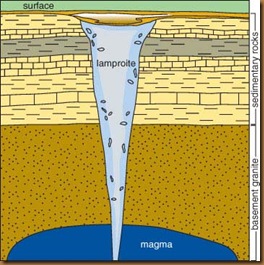 |
| Image courtesy Geokansas at kgs.ku.edu |
Skarn deposits almost always adjoin unaltered quartz monzonite or granodiorite igneous intrusions (“lamproite” in image to right is actually a volcanic rock but the diagram example gives a good visual). They are considered to have formed along fractures in the “country or host rock” or bedrock — this is where hydrothermal veins enter the picture.
What happens is this: the host rocks surrounding the intrusion are converted by heat and substantial metasomatic activity into wide calc-silicate skarn zones, locally dominated by iron and copper mineralization (along with other minerals). Coming soon – Third Question: How are skarns related to copper mineralization, anyway? C-u then!
Selected ReferenceWray, W.B., 2006, Mines and Geology of the Rocky and Beaver Lake Districts, Beaver County, Utah in Bon, R.L., Gloyn, R.W., and Park, G.M., editors, Mining Districts of Utah: Utah Geological Association Publication 32, p. 183-285.In a recent post of mine (1/23/11), Silver Fox commented on a photo I’d posted where two hikers (Terry and Joe, not mentioned then but mentioned now) were admiring the lithic tuff. SF wondered if the subangular fragments might be basalt. I had to admit I didn’t really know for sure as I hadn’t had a chance to examine them closely. Not very sharp-eyed of me, was it?
Be that as it may, I did take a few other photos of larger intact fragments of consolidated ash within the ash fall. Fascinating!
 |
| Cliffs of lithic tuff |
While the others were searching out petroglyphs, for me it was an easy walk up the slope to the lower cliff to do some investigating ~~~
 |
| This boulder layer was amazing! |
 |
| Different ash falls? |
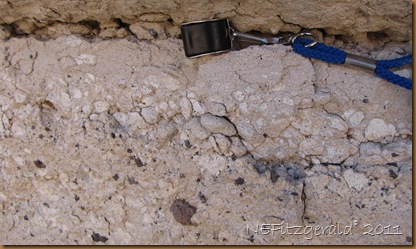 |
| Consolidated ash fragments in the tuff (with other fragments) |
I looked up the definition of “lithic tuff” in my Glossary of Geology (just to be sure I was using the correct terminology) and found this: an indurated deposit (indurated: said of a rock or soil hardened by pressure, cementation, or heat) of volcanic ash in which the fragments are composed of previously formed rocks, e.g., accidental particles of sedimentary rock, accessory pieces of earlier lava in the same cone, or small bits of new lava that first solidify in the vent and are then blown out.
“Tuff” merely refers to consolidated volcanic ash.
“Lithic” refers in this case to the fragments in the ash.
I also collected some small calcite samples from the mine tailings we visited the previous day (posted 1/22/11). They are nothing spectacular, just fun pieces for my yard or shelf ~~~
I screeched and nearly fell over as I saw this lovely quartz crystal just sitting there in the path ~~~
 |
| Nice termination in the crystal |
The heck with looking for gold – the next time I’m wandering around mine tailings in Arizona I need to remember to look for wulfenite. I could surely retire early if I found any!The final hike of our four-day winter getaway–hiking extravaganza in the Laughlin NV area was in Grapevine Canyon. For the first time this weekend, I even had an idea where we were going!
 |
| Grapevine Canyon |
 |
| Grapevine Canyon and main area of petroglyphs |
Located in the Newberry Mountains/Spirit Mountain/Christmas Tree Pass area of Lake Mead National Recreation Area, Grapevine Canyon is well known for its rock art. Very large abstract designs dominate the site. According to the NPS website archaeological evidence of canyon rock shelters indicates that ancestors of modern Mojave people and perhaps Southern Paiute people camped here for a few days at a time as early as 1100 AD; use continued also into modern times.

Many petroglyphs are created by chipping through a dark coat of “desert varnish” to expose an underlying lighter colored rock. Desert varnish is a prominent feature commonly seen coating many rock surfaces in arid regions such as the desert southwest. Another term is “rock varnish” which applies to dark coatings on rocks in general. You can also see desert varnish streaking canyon walls where water has flowed down the walls.
Questions often arise as to why these petroglyph designs and figures were carved into the rock. Why are they here? Who carved them? What do they mean?
My own questions, however, are different. They are not archaeological but geological. What, really, is desert varnish? How does it form?
Over the years I learned (somewhere) that desert varnish is a coating of red iron oxide and black manganese oxide along with bacteria. The bacteria living on the rock absorb manganese and iron from the rock itself and excrete it as a thin layer of black manganese oxide or reddish iron oxide onto the rock surfaces (a biochemical change). This thin layer also helps protect the bacteria from drying out or decaying.
Or so I thought.
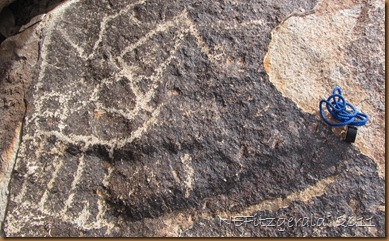 |
| Close-up of petroglyphs on desert or rock varnish |
Interestingly, my Glossary of Geology gives a somewhat different definition of desert or rock varnish that is not really biological: It is a thin dark shiny film or coating composed of iron oxide [with] traces of organic matter, manganese oxide, and silica… It is believed to be caused by exudation [or oozing] of mineralized solutions from within [the rock] and deposition by evaporation on the surface.
Hmmmm… There seems to be some discrepancy here.
 |
| Close-up of petroglyphs on desert or rock varnish |
Apparently, however, the coating of desert varnish is composed mainly of clay minerals. The black manganese oxides and red iron oxides are contained within the clays which are cemented. These clays are found locally where the varnish develops and appear to be derived from airborne dust.
But how far does this airborne dust travel? From southern Idaho? Ontario? Siberia? The rocks at Grapevine Canyon on which the petroglyphs are carved looked granitic. It makes sense, then, that any feldspar minerals making up this granite would be one source of the clays, since feldspars eventually break down to quartz and clays. Perhaps mainly local winds are the reason the clays are airborne, blown around in dust devils and dry desert windstorms.
BTW: I neglected to mention in my last post that I was three-for-three with my on-the-fly field identification skills of yet another lithic tuff. Now I’m four-for-four with varnish and granite and I’ve stopped keeping score.
For desert varnish see: http://minerals.caltech.edu/files/varnish/index.html
Day Three of last week’s winter getaway in Laughlin NV was billed as “Another Surprise Exploratory Hike.” It was certainly a surprise to me because, once again, I had no idea where we were going. The pleasant surprise was that this time the hike leader did.
We drove east out of Laughlin on highway 68 to the optimistically named Golden Valley. After a moment of panic regarding the location of our landmark Maverick store, we turned south and then west into the Black Mountains. Cruising southwest of Kingman in a locality I later discovered to be Sacramento Valley, I found it very bizarre to come across a grid of incredibly well marked dirt roads in such a sparsely populated area. Was someone expecting an enormous influx of residents into this desert quarter of northwest Arizona? Situated somewhere between Kingman and the casinos of Laughlin, it wasn’t very close to either but the infrastructure seemed ready for something.
 |
| End of the road, Black Mountains, NW AZ |
 |
| Some serious arm-waving by the hike leader |
The geology of the Black Mountains was discussed, as best I could without a geological map in sight, in my previous post. These are all Tertiary (≈ 65-2.6 million years) volcanics (see previous post for Harris 1998) of various tuffs, flows, and breccias.
Most remarkable about the hike today were the massive cliffs of lithic tuff (compacted volcanic ash consisting mostly of crystalline rock fragments) that towered all around us as we hiked through our nameless canyon. They were ginormous! It makes me wonder how much ash was actually thrown out of these volcanoes, how long each particular explosion lasted, and how far each layer can be traced on the ground.
 |
| Massive cliffs of lithic tuff in Black Mountains, NW AZ |
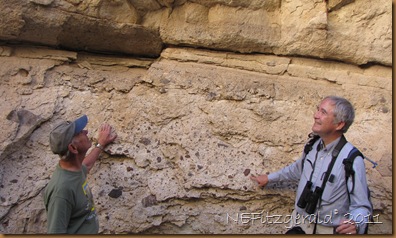 |
| Hikers admiring the tuff |
 |
| Hikers in the tuff |
Back in a canyon the more adventurous in the group (ok, everyone except me) dropped down a steep ravine to view some petroglyphs.
 |
| Dropping down with ropes and ladders |
Since ropes and ladders were involved, I considered my options and chose to stay on top. I roamed here and there, ate some lunch, and investigated at my leisure the nearby geology. Again, I do not know the names of the individual volcanic layers; there would be many fine distinctions between them, often depending on the percentage of one or another mineral (silica, in particular) in their compositions, and how explosive each particular volcanic eruption might have been.
 |
| Massive cliffs of lithic tuff, Black Mountains, NW AZ |
 |
| Plagioclase clast with darker biotite and possibly pyroxene or hornblende |
 |
| Boulders (not basalt) from cliff layers litter the hillside |
 |
| Boulder with opal (hydrous silica) on fracture surface |
 |
| Opal (hydrous silica) on fracture surface of boulder |
 |
| Boulder layer above |
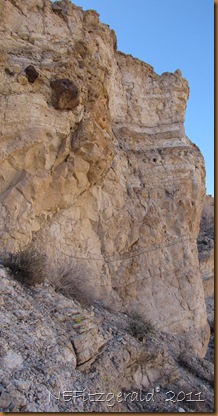 |
| Boulder layer above |
 |
| Later afternoon light on cliffs |
Our Day Two hike near Laughlin NV was billed as “A Two Cave hike in the Oatman Area of AZ with rough rocky terrain and some scrambling.” Monday’s destination of Bighorn Cave a large dry cave with stratified deposits, is in the Mount Nutt Wilderness in the Black Mountains of northwestern AZ, somewhere off Silver Creek Road. It all sounded very intriguing. Again, I put my faith in our hike leaders to locate the cave, since I had absolutely no idea where I was going.
I really do wish we had gotten there.
Driving up a sandy wash, we hadn’t even reached the trailhead when one of the vehicles bogged down and had to be freed from the wet streambed. While other great minds worked out how this extraction would be accomplished, I naturally wandered about looking at rocky outcrops.
These were not the garden-variety metamorphic rocks of the previous day’s hike. In fact, they did not appear to be metamorphic at all. Fine grained, with small clasts of what appeared to be plagioclase and possibly hornblende or pyroxene (I have definite personal issues with field identification of these two minerals) and weathered biotite, I concluded that the rocks I was looking at had to be a lithic tuff (compacted volcanic ash consisting mostly of crystalline rock fragments). I suspected this was all due to Tertiary (65-2.6 million years ago) volcanism and would have to do some research when I got home to be sure.
 |
| Northwestern Arizona volcanic mountains – Silver Creek Rd. |
Meanwhile, I took no close-up pictures of the lovely tuff since I thought we would be coming back to the cars the same way. Silly me! Not only did a vehicle become mired in wet sand but it also turned out that, after walking a couple miles, we (we?) had chosen the incorrect wash to the cave. At this point, despite much animated discussion, no one was quite sure how to get there from there.
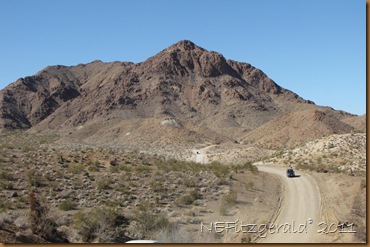 |
| Here come the cars on Silver Creek Rd. |
So we sat on a knoll burning daylight, grazed on our lunches, and waited while several folks from the vehicle-extraction committee walked the 45 minutes back to where we had parked and drove our cars to meet the rest of us along Silver Creek Road. By this time, it was too late to do much of anything except continue the few miles drive to the old mining town of Oatman, drink beer, and amuse ourselves by watching the feral burros lounge around the dusty streets.
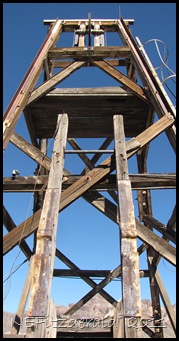
However, several of us were not so thirsty that we didn’t first stop for an hour or so to investigate some nearby mine tailings. We found some nice calcite crystals but no undiscovered mother lode of gold – not even minuscule flecks.
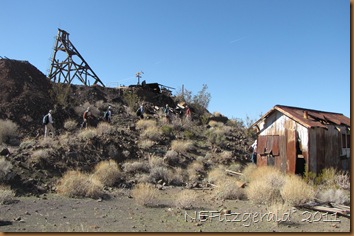 |
| Looking for gold around the mine tailings. |
 |
| Are everyone’s tetanus shots up-to-date? |
Harris (1998) relates that the crystalline basement rocks in the Bullhead City-Black Mountains area consist of “…Precambrian schists (1.7 billion years) and intruded anorogenic (a time between mountain-building events) megacrystic (big crystals) or porphyritic granites (1.4 billion years)…typical of Precambrian granites throughout the southwest…It commonly displays a gneissic texture and is generally weathered and crumbly… The granite is composed of K-feldspar, plagioclase, quartz, biotite, and hornblende.” This is definitely what I was seeing on Sunday’s hike in the Dead Mountains just across the Colorado River. Interestingly, the dates are sort of but not quite comparable to those of the Beaver Dam Mountains in southwest Utah.
 |
| Mountains and mines near Oatman AZ |
I was nowhere near a geological map but was generally spot-on about the general volcanics in Silver Creek. Harris (1998) goes on to say “A thick sequence of mid-Tertiary (30 to 15 million years) igneous rocks covers and is faulted against Precambrian basement … Volcanic rocks include tuffs, flows, and breccias of latite, andesite, and rhyolite.” Most of the mineralization in the Oatman district is hosted by the Oatman Andesite, and to a lesser extent by the Gold Road Dacite. In Silver Creek I figured it was a tuff but couldn’t be more specific than that.
Much has been written about Basin and Range volcanism. Harris (1998) sums it up nicely: “Two episodes of extensional tectonics are responsible for the present [Arizona] topography… A second major episode of faulting, the Basin and Range disturbance, affected western Arizona starting about 12-15 Million years ago … This faulting produced much of the present topography in the Basin and Range Province. Voluminous volcanism accompanied this later faulting.”
Right on! I’m maintaining two-for-two in my on-the-fly field identification skills.
Reference:
Harris, R.C., 1998, A compilation of the geology and hydrology of the Black Mountains-Bullhead City area, Arizona, Arizona Geological Survey Open-File Report 98-26.
Things would have been much simpler if I had known where I was going. But that wouldn’t have been nearly as much fun. As I hiked off into unknown terrain, I knew my geological field identification skills would be put to the test.
First I had to figure out where I was; only then I could figure out the geology. On my latest hiking “weekend winter getaway in Laughlin, Nevada” adventure, the location of each daily hike was nebulous. I had a suspicion of the type of rocks we might be hiking in, but since I didn’t know exactly where we would be going, I couldn’t do any research in advance. I had to fly (and slide down a few slopes) by the seat of my pants.
 |
| Somewhere south of Laughlin, NV |
This past Sunday afternoon, our Utah caravan of cars continued south from Laughlin about eight miles on the road to Needles, CA. I knew we had crossed from Nevada into California when I passed a sign reading “San Bernardino County.” A quick right turn onto a gravel track took us a couple miles up into the foothills of a range later determined (thanks to a brand-new Delorme Atlas & Gazetteer of NV) to be the Dead Mountains
There is much written concerning the tectonic history of this part of the southwest (click here for one interpretation and click on “free” for full text). Going in, I suspected the rocks in these mountains would contain igneous intrusions along with metamorphic schists and gneisses but I had no way of knowing any of the particulars. As I said, though, I did not even know where I was bound until I turned off the highway onto the gravel track.
 |
| On the peak |
Hikers are surely a funny bunch! They rarely want to stop and look at rocks but are most often determined to get as far on a trail or as high on a mountain as possible. Obsessive geology types like me, on the other hand, are content to stay on the same knoll for three hours, walking around with a camera and hand lens to check out whatever is there.
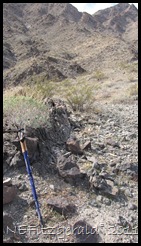
So as the others labored determinedly up the steep, trail-free slope to attain the peak of whatever unnamed mountain we were on, I stayed below to examine the outcrops of weathered schists, gneisses, amphibolites, igneous intrusions, and quartz veins that littered the hillside.
 |
| Weathered schist |
 |
| Quartz vein in darker amphibolite |
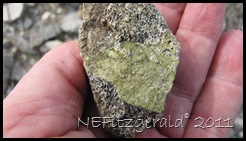 |
| Epidote on amphibolite |
Unlike in the Beaver Dam Mountains of southwest Utah, I did not find any garnet or sillimanite in my cursory three-hour inspection of one knoll. Although absence of evidence does not signify evidence of absence, if there is indeed no sillimanite or garnet in these rocks (and I’m not say there absolutely isn’t – just that I didn’t find any), that would imply lower pressures and temperatures compared to the high-pressure rocks in the Beaver Dams to the north.
 |
| Possible shearing texture in gneiss |
I did notice what I thought were possibly some shearing textures, though, but they didn’t jump out at me. By this time I was wishing I had some thin sections to look at under the petrographic microscope.
The only information I found (after an hour’s literature search on the internet, three days after the hike) was a map on the California Geological Survey website (also zoom in here to just southwest of Bullhead City, AZ). The ridgeline of the Dead Mountains is mapped as Precambrian rocks but nothing more specific. Woo Hoo! So far, I’m batting a thousand for field identification skills on the fly.
This week I bid a fond farewell to my semionotid.
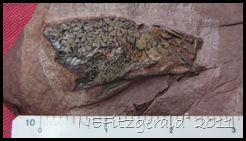 |
| Ruler is in inches |
It was a good fish, as far as 210-million year old Late Triassic fossil fish go. I had done all the prep work that needed doing for now on this little guy at the St. George Dinosaur Discovery Site at Johnson Farm and so for one last time I tucked it carefully and lovingly back into its museum drawer. Goodbye, old friend! Maybe we’ll meet again someday at the Utah Museum of Natural History! It’s time to move on to a new fish.
 From the drawer I chose a broken sample that looked intriguing. There were many small scattered patches of fish scales visible on one large flattish surface of the reddish brown mudstone; also visible from the side and parallel to this surface was a thin line of scales about an inch long.
From the drawer I chose a broken sample that looked intriguing. There were many small scattered patches of fish scales visible on one large flattish surface of the reddish brown mudstone; also visible from the side and parallel to this surface was a thin line of scales about an inch long.

What lies hidden underneath those mudstone layers? It may be one fish in there, or it may be many; it might be one relatively intact specimen, or it might be a jumbled mush of small fish carcasses all piled on top of one another. Time will tell as I meticulously start to pick away at the matrix, layer by layer.
 |
| Needle tip at fish scales |
This new sample (along with many others, including the above-mentioned “old friend”) was brought back from an on-going study area in San Juan County near Moab, Utah. According to Andrew Milner, paleontologist with the Dinosaur Discovery Site, it had originally been thought that these fish came from the 210-million year old Owl Rock member of the Chinle Formation, but is now believed to be from the oh-so-slightly younger Church Rock member.
The Owl Rock represents deposits in a large, not very fossilliferous lacustrine (lake) system, whereas the Church Rock member represents a unique area of a huge fluvial (river) system. Here, massive amounts of material were transported into the system from highlands to the east and west.
 |
| Image courtesy Utah Geologic Survey |
According to the Utah Geological Survey, a Late Triassic Chinle fluvial (river) system covered much of the Western Interior of North America. Sources of these Chinle rivers were in remnant highlands of the Appalachian Mountain system.
Another interesting specimen being prepped (not by me) is shown in the images below. Notice at the lower left of the photo how its fin has folded underneath the fish. Also, notice the fine detail of the fins, bones, and scales.
What really impressive prep work!
This is also a semionotid and is very likely a new species.
However, this semionotid is not from eastern Utah but was found in an area of the Dinosaur Discovery Site @ Johnson Farm known as Freeman Quarry. It was found in the upper part of the Whitmore Point member of the Early Jurassic Moenave Formation, about 200-198 million years old.
For an interesting article on the “fishing dinosaurs” at the edge of southwest Utah’s prehistoric Lake Dixie, click here
Thanks to Andrew Milner for taking the time to explain the nuances of the Owl Rock and Church Rock members of the Late Triassic Chinle Formation and also of the Whitmore Point member of the Early Jurassic Moenave Formation.
For stratigraphic and lithologic columns see Biek, R.F., Willis, G.C., Hylland, M.D., and Doelling, H.H., 2000, Geology of Zion National Park, Utah, in Sprinkel, D.A., Chidsey, T.C., and Anderson. P.A., editors, Geology of Utah’s Parks and Monuments, Utah Geological Association Millennium Guidebook Publication 28, p. 110-111.







